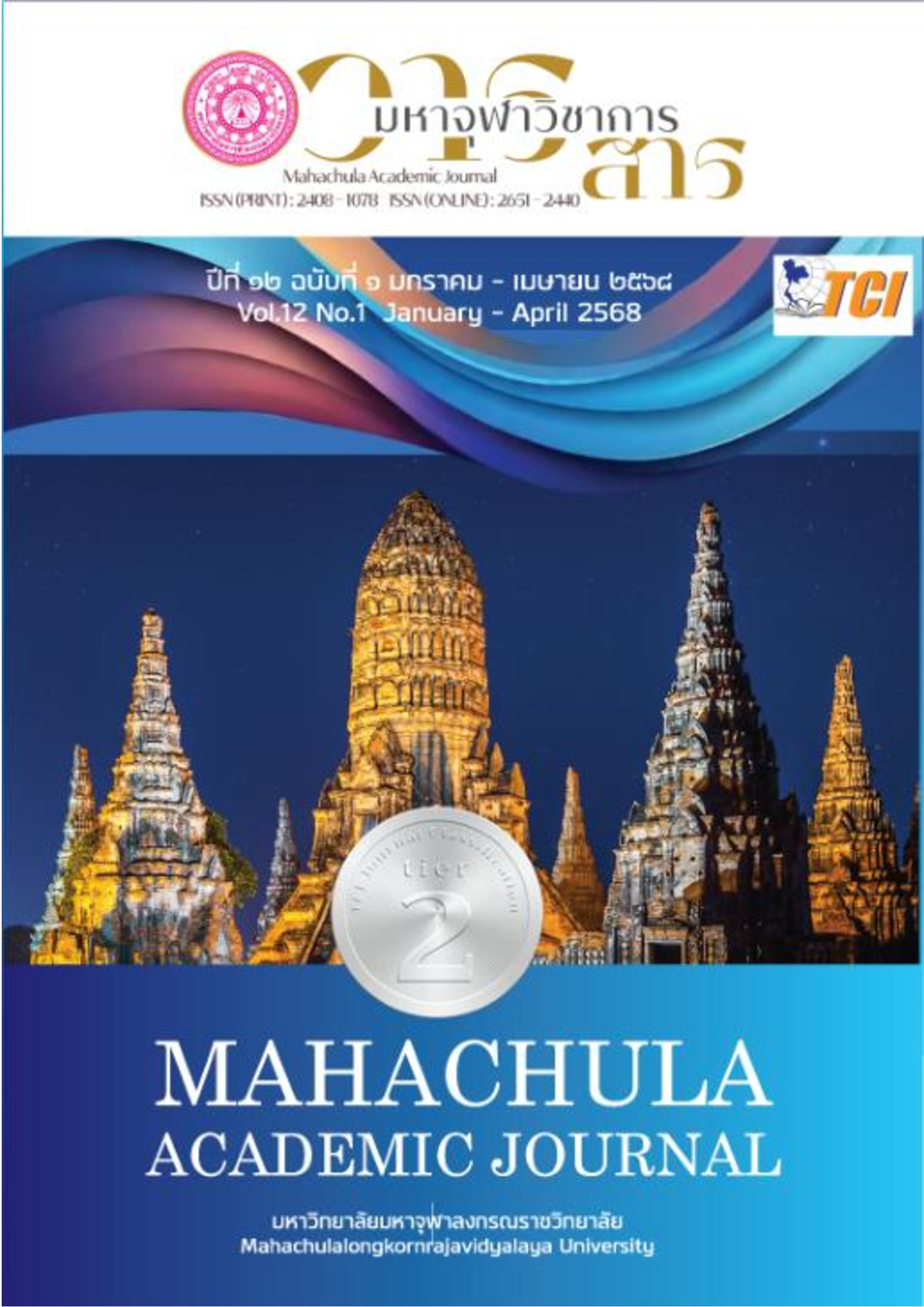Dissemination Models of Knowledge and Just Practices as Depicted in the Ten Jataka Tales via Digital Online Platforms
Main Article Content
Abstract
This research article has three objectives: 1) To study the knowledge and practices of justice as depicted in the Ten Jataka Tales; 2) To develop a model for disseminating the knowledge and practices of justice as depicted in the Ten Jataka Tales through an online digital system; and 3) To present innovative methods for disseminating the Ten Jataka Tales creatively on an online digital database. The research will employ a documentary research method, involving the study of data from the Tipitaka, commentaries, related documents and research, interviews with five experts, data analysis, data compilation, and presentation of data through content analysis and descriptive analysis.
The research result found that; (1) The knowledge and practices of justice as depicted in the Ten Jataka Tales can be divided into two parts: the first part is the ten perfections cultivated by the Bodhisattva, and the second part is the concept of justice as it appears in the Ten Jataka Tales. The first part, the continuous cultivation of perfections by the Bodhisattva in the Ten Jataka Tales, includes: generosity, morality, renunciation, wisdom, energy, patience, truthfulness, determination, loving-kindness, and equanimity. The second part, the concept of justice as it appears in the Ten Jataka Tales, encompasses various aspects such as: treatment of prisoners, the disabled, and the general public; dealing with envious individuals within an organization; the use and distribution of royal power, and the prevention of power struggles; the firmness and wisdom of leaders; social welfare; the virtues of a good person; donations of auspicious elephants, the great offering of seven hundred sets of robes, sons, daughters, and wives, and so on. (2) There are three primary digital online formats for disseminating knowledge and the practice of justice as depicted in the Ten Jataka Tales: the evidence-based presentation format, which provides data on the Jataka Tales that reflects the embedded knowledge and practices of justice; the instructional presentation format, which highlights key points, significant individuals, events, and principles or moral values that can be applied to benefit individuals and society; and the persuasive presentation format, which aims to motivate the audience to create positive things that benefit themselves, others, or society as a whole.
Article Details

This work is licensed under a Creative Commons Attribution-NonCommercial-NoDerivatives 4.0 International License.
References
กรกนก ศรีสุวรรณ และสุวิญ รักสัตย์. “แนวทางความรับผิดชอบต่อหน้าที่ตามวิถีพระโพธิสัตว์ที่ปรากฏในมหานิบาตชาดก”. วารสารวิจัยธรรมศึกษา. ปีที่ ๖ ฉบับที่ ๑ (มกราคม-มิถุนายน ๒๕๖๖): ๒๔๗ - ๒๖๐.
ชลวิทย์ อรุณปราการ นวลวรรณ พูลวสุพลฉัตร และสรวิชญ์ วงษ์สะอาด. “การใช้บารมี ๑๐ ในการพัฒนาตนเองและสังคม”. วารสารนวัตกรรมการจัดการศึกษาและการวิจัย. ปีที่ ๔ ฉบับที่ ๑ (มกราคม – มิถุนายน ๒๕๖๕) : ๔๙ - ๕๖.
มหาวิทยาลัยมหาจุฬาลงกรณราชวิทยาลัย. พระไตรปิฎกภาษาไทย ฉบับมหาจุฬาลงกรณราชวิทยาลัย. เล่มที่ ๒๒, ๒๗ – ๒๘. กรุงเทพมหานคร: โรงพิมพ์มหาจุฬาลงกรณราชวิทยาลัย, ๒๕๓๙.
มหาวิทยาลัยมหาจุฬาลงกรณราชวิทยาลัย. อรรถกถถาพระไตรปิฎกภาษาไทย ฉบับมหาวิทยาลัยมหาจุฬาลงกรณราชวิทยาลัย. อรรถกถาขุททกนิกาย ชาดก ภาคที่ ๑ - ๑๐. กรุงเทพมหานคร: โรงพิมพ์มหาจุฬาลงกรณราชวิทยาลัย, ๒๕๕๗.
ม.ร.ว.คึกฤทธิ์ ปราโมช. ปัญหาประจำวันชุด “รู้ไว้ใช่ว่า”. กรุงเทพมหานคร: สำนักพิมพ์สยามรัฐ, ๒๕๓๑.
สมเด็จพระพุทธโฆษาจารย์ (ป. อ. ปยุตฺโต). พจนานุกรมพุทธศาสตร์ ฉบับประมวลธรรม (Dictionary of Buddhism). พิมพ์ครั้งที่ ๔๖. กรุงเทพมหานคร: สหธรรมิก, ๒๕๖๕.
สุวรรณา สถาอานันท์. “เมตตาธรรม - ความเป็นธรรมในเวสสันดรชาดก”. รายงานการวิจัยฉบับสมบูรณ์. กรุงเทพมหานคร: สำนักงานคณะกรรมการส่งเสริมวิทยาศาสตร์ วิจัย และนวัตกรรม, ๒๕๕๑.
สุภัค มหาวรากร และพฤทธิ์ ศุภเศรษฐศิริ. “การสร้างสรรค์ชาดกเรื่องพระมหาชนกในรูปแบบการ์ตูนโทรทัศน์”. วารสารไทยศึกษา. ปีที่ ๑๐ ฉบับที่ ๑ (กุมภาพันธ์ – กรกฎาคม ๒๕๕๗) : ๒๗ - ๕๓.
หม่อมอัญชลี ยุคล ณ อยุธยา. “แนวคิดปรัตถนิยมในฐานะรากฐานแห่งจิตอาสา”. วารสาร มจร ปรัชญาปริทรรศน์. ปีที่ ๑ ฉบับที่ ๒ (กรกฎาคม - ธันวาคม ๒๕๖๑) : ๑๔ - ๒๒.
Rawls, John B. A Theory of Justice. Revised Edition. The Belknap Press of Harvard University Press, Cambridge, Massachusetts, 1971.
“ทฤษฎี SMCR ของเบอร์โล (Berlo)”. [ออนไลน์]. แหล่งที่มา: https://www.gotoknow.org/post/674697, and https://www.baanjomyut.com/library/communication_theory/03_2.html [๒๙ ธันวาคม ๒๕๖๗].

